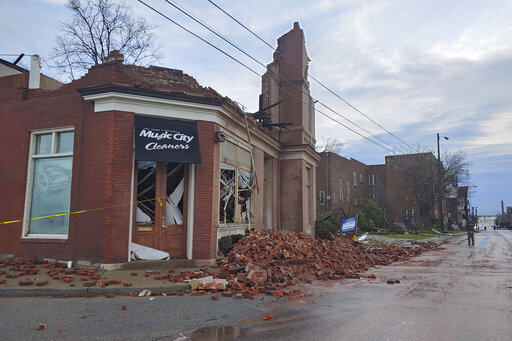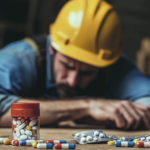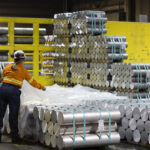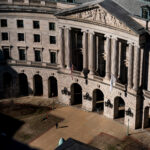NASHVILLE, Tenn. — Property owners affected by the tornadoes earlier this month now face two options: rebuild or bulldoze.
The storms damaged or destroyed hundreds of homes and businesses throughout Middle Tennessee. And historic buildings will require extra care.
Just hours after a tornado tore through East Nashville, architectural historian Robbie Jones stood outside his office in Five Points. The 125-year-old building was in shambles. Jones couldn’t believe what he was seeing.
“We all cried, and then we rolled up our sleeves and got to work because we had to get our offices, what we could, salvaged, out, before the building _ it was actually collapsing while we were salvaging things, the roofs were caving in,” Jones says.
A week later, Jones and I are standing on the front lawn of his crumbling office building on South 11th Street, soaking in the scene.
Most of the street is blocked off by utility trucks, as crews work to replace downed electric poles. Windows are boarded up, roofs covered with blue tarp. Piles of rubble spill from the outer walls of collapsing homes.
“The steeple from the church, two doors down, landed on top of our building upside-down and demolished an entire section of the building,” Jones says. “So, while the front looks OK, when you go inside and go to the rear, it’s just, it’s in shambles.”
Jones doesn’t know if the structure can be repaired. He says preservationists might have to remove historic relics that survived — mantles, doors, trim — piece by piece.
And he says historic buildings like this give East Nashville its character.
Four squares, bungalows and Victorians cropped up around the streetcar suburb in the mid-nineteenth century, Jones says, with the hope that the area would be compact and walkable. And that, he says, is why the community is so strong. Because it’s been that way for a century-and-a-half.
“This tornado seemed to hit — strike the historic neighborhoods the hardest,” Jones says. “And that’s the most heartbreaking for us that love historic buildings, neighborhoods, and do this for a living, because so many of those were demolished and damaged beyond repair.”
But Fred Zahn, from the Metropolitan Historical Commission, says some older buildings actually fared better than newer ones, because of higher construction standards at the time they were built.
“That’s the upside of these historic buildings, is that they are almost infinitely reparable, because their bones are so good,” Zahn says.
Still, that only goes for buildings with bones left to save. Zahn says preservationists have to be realistic.
“We’re not going to require a person to spend an onerous amount of money putting back something that’s largely gone,” he says.
But he adds that the commission strives to save historic structures whenever the damage is minor enough that it can be repaired. That’s because historic buildings are a “finite resource,” Zahn says.
“You can’t just go out and build something historic,” he says. “One of the things that most cities pride themselves on is a sense of identity and what makes them special. And the more of that you lose _ either to some type of tragedy or natural disaster, or to development _ the more of that historic fabric you lose, you can’t help but lose a certain degree of identity.”
Robbie Jones, the historian, hopes any rebuilding that happens honors the historic nature of the city’s oldest neighborhoods. The last thing he wants is for developers to swoop in and demolish buildings that could be saved, just to make way for tall skinnies and Airbnb’s.
“No one is anti-development. We just want it to be done correctly and make sure the neighbors are, their opinions are brought to the table, because we actually live here. We’re the ones who helped save the neighborhood,” he says.
David Paine is also worried about post-tornado redevelopment across the river in Germantown. He’s a real estate agent with multiple listings in historic buildings in the neighborhood, and also served on the Metro Historic Commission for seven years.
“When you lose structures, and something new gets built in, there’s always the risk that what you lost was better than what you get,” Paine says.
He worries that redevelopment after the tornado will speed up gentrification in the neighborhood. That’s what happened in East Nashville in the late 90s.
“I hope that what is done and re-done in Germantown can be done with care for the architectural fabric and care for the human beings that live there,” he says.
Paine says he’s shocked by the randomness of the tornado. Some of his favorite buildings survived completely unscathed. Others, like those that housed the Geist restaurant and Music City Cleaners, along Jefferson Street, were damaged, perhaps beyond the point of repair.
“The thing that really is very difficult to accept is the irreplaceable Victorian structures that are destroyed,” he says. “The corner store, the corner of Jefferson and 7th, is in complete ruin. And that was, sort of, a neighborhood entry point that was, sort of, a marker for the beginning of Germantown, and it’s gone.”
Two blocks away, on the corner of 7th Avenue and Monroe Street, the Catholic Church of the Assumption is still assessing the damage to its property. Piles of blown-off bricks are stacked beside the scaffolded wall. Many of the stained-glass windows are shattered.
Laura Cooper is the church’s office manager. She watched the tornado pass through on the weather radar and knew the congregation must have been hit.
“We really haven’t had time to process what’s happened to us,” Cooper says. “We’ve been so busy dealing with covering the roof, securing the building, acting in crisis mode.”
Cooper is still waiting for all the estimates from the insurance company. She says replacing the stained-glass windows, alone, will cost more than $600,000.
“We ask people to pray. Pray for the structure of the building, pray for the knowledge of the people who are doing the work, making the decisions for the dioceses of Nashville, the other churches, the other people that have been affected. The people that have lost their lives,” she says. “I mean, there’s still so much to be thankful for. But, you know, I think everybody in the area needs prayer.”
Cooper doesn’t know if the Catholic dioceses will decide it’s worth spending the money to rebuild. But for now, they’re using makeshift spaces to keep holding mass and baptizing babies. Anything to make this moment feel a bit more normal.
Some other notable historic buildings damaged in the tornadoes:
- The Catholic Church of the Assumption (1859, 1227 7th Ave. N., Germantown)
- Tennessee State Prison (1898)
- Geist, John, and Sons, Blacksmith Shop and House (1900, 309-311 Jefferson St., Germantown)
- Dodson Chapel United Methodist Church (1903, 4107 Dodson Chapel Rd., Hermitage)
- East End United Methodist Church (1905, 1212 Holly St., East End)
- Third Baptist Church/Hopewell Missionary Baptist Church (1906, 908 Monroe St., Buena Vista)
- Music City Cleaners/TheLab Nashville (1910, 624 Jefferson St., Germantown)
- Temore Willis Home (1910, 1006 Monroe St., Buena Vista)
- The Church at Lockeland Springs (1910, 1601 Holly St., Lockeland Springs)
- Holly Street Fire Hall (1914, 1600 Holly St., Lockeland Springs)
- North Branch Library (1915, 1001 Monroe St., Buena Vista)
About the photo: This recent photo, shows the tornado damaged to the Music City Cleaners in Nashville, Tenn. Fred Zahn of the Metro Historical Commission predicts it “will rise again.” (Samantha Max/WPLN News)
Was this article valuable?
Here are more articles you may enjoy.


 A True Alternative to Opioids for Workers’ Comp? Questions Remain
A True Alternative to Opioids for Workers’ Comp? Questions Remain  Musk Blames X Outage on Cyberattack
Musk Blames X Outage on Cyberattack  Trump Says He’s Doubling Tariffs on Canadian Steel, Aluminum
Trump Says He’s Doubling Tariffs on Canadian Steel, Aluminum  Trump Mounts Sweeping Attack on Pollution and Climate Rules
Trump Mounts Sweeping Attack on Pollution and Climate Rules 